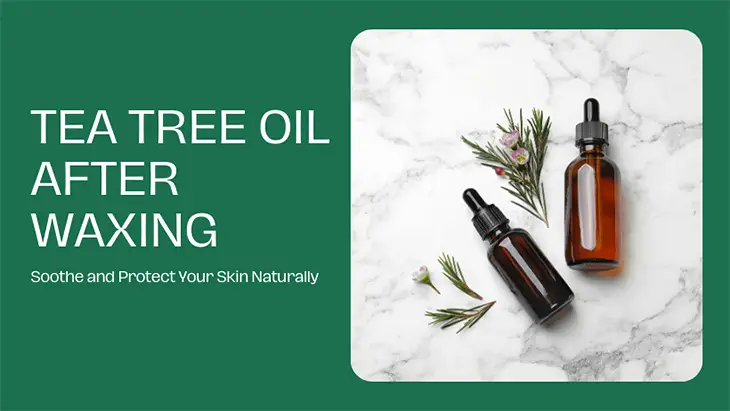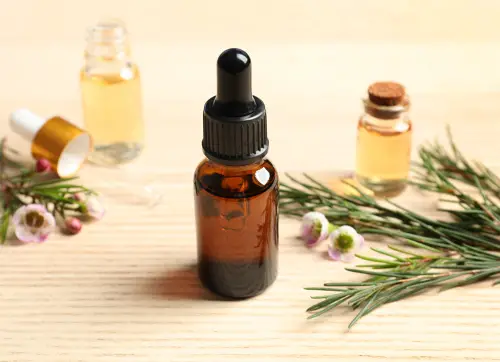
Ever experienced that familiar sting and redness after a waxing session? We’ve all been there, searching for a soothing solution. And you’re in luck. Tea tree oil might just be the post-waxing hero you need. Yes, you can use tea tree oil after waxing, and it’s a game-changer for calming your skin.
In this guide, we’ll explore how this natural wonder can enhance your post-wax routine, not only soothing your skin but also harnessing its natural healing properties. Let’s delve into the world of tea tree oil and discover how it can revolutionize your post-waxing care.
Table of Contents
- Why Tea Tree Oil is Amazing for Your Post-Wax Routine
- Tea Tree Oil After Waxing: Best Practices and Care Tips
- How to Use Tea Tree Oil After Waxing
- Conclusion
Why Tea Tree Oil is Amazing for Your Post-Wax Routine
Waxing, while effective for hair removal, can be quite harsh on the skin. Waxing, while effective for hair removal, can sometimes be tough on your skin. It’s not just about removing hair; it’s also about caring for the skin that’s been stressed by the process. This is where the natural wonders of tea tree oil come into play.
Natural Antiseptic and Anti-Inflammatory Properties
Tea tree oil is highly regarded for its natural antiseptic properties. When you wax, the process not only removes hair but also can leave tiny wounds in the form of ripped hair follicles. Applying tea tree oil can help prevent bacteria from entering these open pores, reducing the risk of infection and breakouts.
Additionally, its anti-inflammatory properties are a blessing for inflamed and irritated skin, common after waxing. Whether it’s the redness on your face after an eyebrow wax or the sensitivity of your bikini line post-Brazilian, tea tree oil works to soothe and calm the skin.
Combatting Post-Wax Bumps
A common concern post-waxing is the appearance of red bumps. These are often due to irritation or minor inflammation of the hair follicles. Tea tree oil’s anti-inflammatory qualities help reduce the swelling associated with these bumps, soothing your skin and providing relief from irritation. Its antiseptic nature also plays a key role in preventing these bumps from becoming infected.
Accelerating the Healing Process
One of the standout qualities of tea tree oil is its ability to facilitate faster healing of the skin. Scientific research supports its role in reducing inflammation and promoting the healing of minor wounds, which aligns perfectly with the needs of post-wax care.
Soothing and Moisturizing
Apart from its healing properties, tea tree oil also acts as a soothing agent. It helps in reducing the itchiness and discomfort that often follows waxing. Moreover, when blended with carrier oils like coconut or almond oil, it provides moisture to the skin, ensuring it doesn’t dry out or become overly tight after waxing.
A Word on Safety and Application
While tea tree oil is beneficial, it’s important to use it correctly. Always dilute it with a carrier oil, especially for use on sensitive skin areas. A patch test is also recommended to rule out any allergic reactions.

Tea Tree Oil After Waxing: Best Practices and Care Tips
Navigating the use of tea tree oil in your post-wax care routine can be straightforward if you know the do’s and don’ts. Whether it’s after sugaring, a Brazilian wax, or any other type of hair removal, these tips will ensure you use tea tree oil safely and effectively.
Do’s for Using Tea Tree Oil Post-Wax
- Do Dilute: Always mix tea tree oil with a carrier oil before applying it to your skin to avoid irritation.
- Do Patch Test: Before applying tea tree oil to a waxed area, conduct a patch test to ensure you don’t have an allergic reaction.
- Do Apply Gently: Use a cotton ball or pad to softly apply the diluted oil to the waxed area. This is especially important for sensitive skin and sensitive areas.
- Do Use on Different Wax Types: Tea tree oil is versatile and can be used after various waxing methods, including sugaring and Brazilian waxes. It’s gentle yet effective for different skin types and areas.
Don’ts to Remember
- Don’t Apply Undiluted Oil: Direct application of undiluted tea tree oil can be harsh on the skin, particularly post-wax.
- Don’t Overuse: Stick to applying the oil 2-3 times a day for the first couple of days post-wax, then reduce as the skin heals.
- Don’t Ignore Irritation: If you experience any adverse reactions, discontinue use immediately.
Special Considerations for Sensitive Areas
- Sensitive Skin Areas: For areas like the face and bikini line, use a lower concentration of tea tree oil in your dilution to avoid potential irritation. Also, it’s advisable to apply a soothing aloe vera gel post the tea tree oil application for added comfort and hydration.
- After Brazilian Waxes: Post-Brazilian wax skin is particularly sensitive. Apply a mild concentration of tea tree oil gently to soothe and protect the area.
Addressing Common Questions
- Is it safe for all skin types? While tea tree oil is generally safe, those with sensitive skin should use a lower concentration and always do a patch test.
- Can it be used immediately after waxing? It’s best to wait until the skin has cooled and any irritation has calmed slightly. If your skin is particularly reactive, wait a few hours before applying.
By adhering to these guidelines, you can make tea tree oil a safe and effective part of your post-waxing care routine, ensuring comfort and skin health no matter the waxing method you choose.
How to Use Tea Tree Oil After Waxing
Understanding the benefits of tea tree oil for post-wax care is one thing; knowing how to use it correctly to maximize its effects is another. Here’s a straightforward guide to get you started.
Step-by-Step Application Guide
- Dilution is Key: Pure tea tree oil can be quite potent. To avoid irritation, dilute it with a carrier oil. A good rule of thumb is to mix a few drops of tea tree oil with a tablespoon of carrier oil like jojoba, coconut, or olive oil.
- Test Before Use: Before applying tea tree oil to a waxed area, do a patch test. Apply a small amount on your inner arm, wait for 24 hours to see if there’s any adverse reaction.
- Gentle Application: After waxing, once the skin has cooled down and is dry, apply the diluted tea tree oil gently onto the waxed area using a cotton ball or pad. Avoid rubbing vigorously.
- Frequency: For the first 24-48 hours post-wax, you can apply tea tree oil mixture 2-3 times a day. After this period, once daily is sufficient until the skin has fully recovered.
Post-Application Care
After applying tea tree oil, avoid exposure to direct sunlight as the skin might be more sensitive. Also, refrain from applying heavily fragranced lotions or products that could irritate the skin.
By following these steps, you can harness the power of tea tree oil to aid in your post-wax recovery effectively and safely. In the next section, we’ll delve into tackling specific post-wax issues like bumps and irritation using tea tree oil.
Conclusion
In conclusion, tea tree oil emerges as a versatile and effective solution for post-wax care. Its natural antiseptic and anti-inflammatory properties make it ideal for soothing skin, reducing irritation, and aiding in the healing process. By following the simple guidelines of dilution, patch testing, and gentle application, you can safely incorporate tea tree oil into your post-wax regimen. Embrace this natural remedy and give your skin the gentle care it needs after waxing.
Related content:
What Oil Should I Use After Waxing?

Petra Nakashian (previously Kravos) is a dedicated natural health and beauty blogger, driven by the loss of her parents to cancer, which led her to meticulously research beauty product ingredients. With over 10 years of experience, her in-depth knowledge has made her a trusted expert in the field. Founder of Be Healthy Now and Green Beauty Talk, Petra recently expanded her expertise with Beauty Insights Hub, exploring a wider range of beauty treatments. Committed to transparency and honesty, her work is a vital resource for navigating the complex world of beauty.

